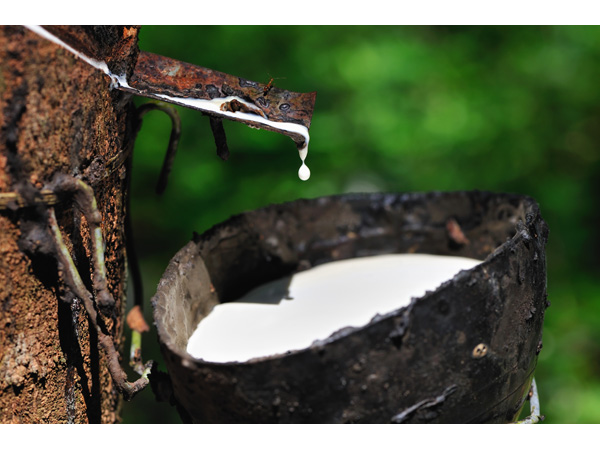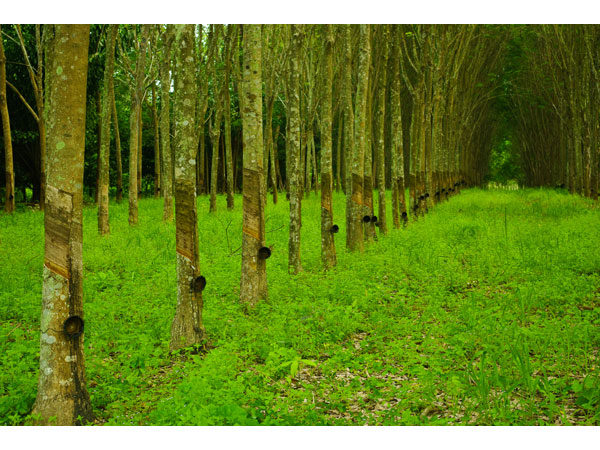100% Natural Latex Foam

What are the ingredients of natural latex foam for upholstery?
All 100% (truly) natural latex, whether organic or not, contains the following ingredients:
95% Natural Latex Rubber – pure, natural rubber harvested from the Hevea Brasiliensis (rubber) tree, which grows primarily in southeast Asia. It contains no petroleum products, flame retardants, or other harmful chemicals.
The remaining ingredients are foaming agents that are essential to the vulcanization, foaming and curing process that all latex foam cores must go though during the production process:
2% Zinc Oxide
1% Fatty Acid Soaps
1% Sulfur
1% Sodium
Once production is complete, the finished foam is then washed a minimum of 3 times to remove any residuals that may be left over after curing.
How & where is natural latex foam made?
The raw material for latex foam is obtained by tapping rubber trees in much the same way maple trees are tapped to make maple syrup. Trees in a rubber plantation are used for milk harvest for about 30 years before they are replaced with new trees – the wood from the old trees is highly valued by furniture and toymakers.
Historically, latex milk was harvested by small holdings in southeast Asia. Today larger plantations have been established to meet the growing demand. The raw material is processed into 100% natural or used in blended natural/synthetic latex. Note that synthetic latex is produced without the milk from the tree. It is a petroleum-based product, often comprised of Styrene Butadiene Rubber (not a health friendly alternative).

Latex foam buyer beware:
Latex blends and synthetics are often blanket-labeled by suppliers as “natural”, creating confusion about what you’re actually getting. Be sure to ask for certification.
GOLS Organic vs ‘Oeko-Tex Standard 100’ Certification
Third Party Certification
There are a number of independent organizations that offer certification programs for various industries and products. When it comes to natural latex, there are two prominent certification standards that are internationally recognized: GOLS and Oeko-Tex.
What is GOLS?
The Global Organic Textile Standard (GOTS) is considered the world’s leading textile processing standard for organic fibers, including ecological and social criteria, backed by independent certification of the entire textile supply chain. The GOLS standard, or ‘Global Organic Latex Standard’ is administered by the same organization.
The Global Organic Latex Standard assures that the final product of a latex core is certified – including strict governance over growing procedures at the plantations, manufacturing procedures at the moulding facility, packaging, and assurance that workers’ wages are paid out fairly and their working conditions are respectable.
What’s the difference between GOLS Organic & Oeko-Tex Certifications?
- GOLS (the Global Organic Latex Standard) was introduced in 2012 to ensure a clear path and procedure from farm-to-label: from rubber plantation, to manufacturer, to certified organic latex end product. Organic latex foam produced under the GOLS label must follow a strict protocol of documentation from start to finish, assuring the end product is both socially and environmentally responsible and meets international health & safety standards.
- The Oeko-Tex Standard 100 is concerned primarily with health and safety of textile products (including latex foam). It tests only the end product, not the processing – for example, wastewater treatment is not included, nor are worker conditions. It is NOT an organic certification and products bearing this mark are not necessarily made from organically grown fibers. Look for the GOTS or GOLS label for organic certification.
What does the Oeko-Tex Standard 100 test for?
Textile products bearing the Oeko-Tex 100 certification mark:
- Do not contain allergenic dye-stuffs and dye stuffs that form carcinogenic arylamines.
- Have been tested for pesticides and chlorinated phenoles.
- Have been tested for the release of heavy metals under artificial perspiration conditions.
- Formaldehyde is banned; other aldehyde limits are significantly lower than the required legal limits.
- Have a skin friendly pH.
- Are free from chloro-organic carriers.
- Are free from biologically active finishes.
(Thanks to the Two Sisters Ecotextiles blog for this information)

Dunlop or Talalay?
There are two manufacturing processes used in the production of latex foam: Talalay & Dunlop. Both processes are used in the manufacture of 100% natural as well as blended (synthetic/natural) latex. Therefore, not all latex labeled as ’Talalay’ or ‘Dunlop’ are 100% natural.
In the Talalay process, only a small amount of ‘whipped’ latex compound is poured into the mold. Air is extracted to evenly distribute the foamed liquid inside the mold and to create a consistent open cell structure. The foam core is then flash frozen to lock the cell structure in place and to prevent the particles from settling.
The Dunlop process is similar to the Talalay process except that the mold is filled to the brim and there is no vacuum or freezing stage. The Dunlop process can create a firmer feeling, denser product, with a somewhat less even distribution of latex.
See ‘Talalay vs Dunlop Latex: What’s the Difference?’ for a more in-depth look at the two processes.
How do I choose the latex firmness that’s right for my specific upholstery application?
Optimal firmness of latex foam for upholstery is a subjective judgement. Please see the post ‘Natural Latex Foam for Upholstery: Firmness & Density’ for an in-depth look at how to choose latex firmness for your upholstery project.
What about Latex Allergies?
The issue of latex allergies is a very difficult and challenging illness, and thus an important issue that must not be ignored. I have spoken with many people who are afflicted with severe allergies, albeit mostly involving the chemicals in the urethane foam or fabrics in their furniture. This is the main reason we offer the latex foam – as an alternative for those individuals. Following is some information I have found regarding latex allergies:
All 100% latex from the Hevea brasiliensis tree has naturally occurring proteins, which can cause an allergic reaction in some individuals. Latex foam goes through a thorough washing process that removes those proteins. The latex gloves used in the medical industry (which are most often associated with latex allergies) often do not go through this stringent washing process, and (unlike upholstery or mattress foam) are in direct contact with the person’s skin. There is a widely-made claim that the particular type of allergy ‘latex allergy (contact or respiratory)’ that can be caused by the raw material natural latex (the sap of the rubber tree) can not be caused by sitting on a latex cushion or sleeping on a latex mattress or pillow, because:
- the latex cores are washed thoroughly
- the proteins in the natural latex responsible for the possible allergic reaction are destroyed by the high temperatures during vulcanization in production
- the cover of the cushion protects the skin against any direct contact
Despite this claim, I would still recommend that people with acute or life-threatening allergies should always practice caution and seek the advice of their doctor or health professional. In the end we must each make our own judgements based on our personal experience. For more information on latex allergies, check out The Mattress Underground.
Leave A Comment